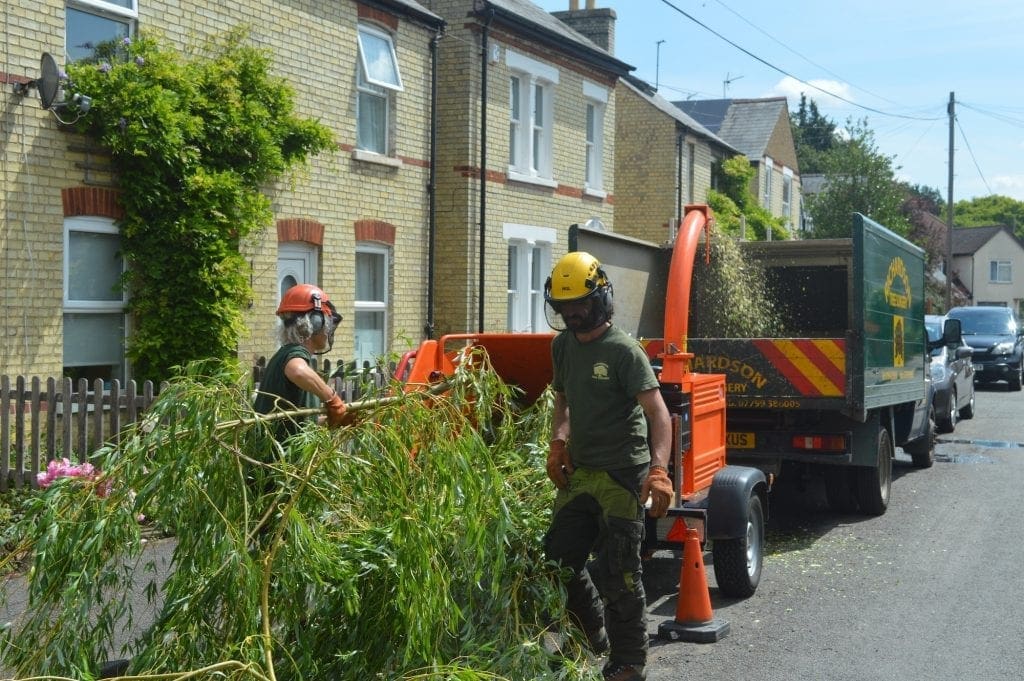Our Services
Richardson Tree Surgery focuses on maintaining trees and hedges to the highest standards, at competitive prices. We don’t do gardening, paving, fencing or landscaping, but are happy to recommend some fantastic companies that do.
Tree Felling
This involves removing trees standing in open spaces, where there is plenty of room to carry out the work. Straightforward tree felling involves cutting the tree at the bottom and bringing it down in one go. Sometimes, the surrounding area may have obstacles which can prevent us from doing this, so the tree is felled in sections instead.
Tree Dismantling
When a tree is in a confined area or close to a property, straightforward tree felling is often not possible. Instead, we carry out tree dismantling. This involves taking the tree down piece by piece, using specialist equipment and lowering systems. We occasionally hire cherry pickers for trees that cannot be climbed safely.
Crown Lifting
Crown-lifting involves the removal of the lower branches of a tree in order to increase the clearance between the ground level and the lower branches to allow access below the tree, to clear utility lines, allow more light into your garden or to improve views.
Crown Reduction/Thinning
The crown of a tree is what catches the force of storms. When wind catches the crown, it can cause limbs to fail and break off or the tree itself to uproot. Crown reduction can reduce the possibility of such damage. The top of a tree acts as a sail, especially when in leaf, and when the wind blows the crown catches the wind. We also recommend crown-thinning, which minimizes the damage caused by high winds, especially to trees which are in good vigour.
Stump Grinding
Our small stump grinder is perfectly designed to access virtually all back gardens, even if it has to go through a house. It can tackle small and medium sized stumps to a depth of 250mm. The access width needed is only 700mm and the machine weighs 150kg. Our large stump grinder only needs a little more access width of 800mm, but since it is on tracks and weighs 650kg, it is more suited to larger stumps with good access to their location. This 38HP machine can tackle any size stump, grinding to a depth of just over 300mm.
Formative Pruning
Formative pruning is generally completed when a tree is very young (generally up to 5-10 years), although it can be carried out on more mature specimens. It encourages the tree to grow into an attractive and healthy structural form. Ideally, this pruning should be started when the tree is in the nursery in order to influence the structure, shape or size of its crown. Formative pruning is used to remove any future weaknesses in the tree and to give a desired shape. Potential weaknesses are caused by crossing branches or any part of the tree that has grown in an unusual way.
Fruit Tree Pruning
Fruit tree pruning is the cutting and removing of selected parts of a fruit tree. It spans a number of horticultural techniques. Pruning often means cutting branches back, sometimes removing smaller limbs entirely. It may also mean removal of young shoots, buds, and leaves. There are specific times of the year when fruit trees should be pruned
Winter Pruning
Mainly for Apple, Pear and Quince trees to encourage vigorous growth. If you want new shoots and more flowers, and therefore more fruit, prune in the Winter. Pruning at this time of year, when the leaves have fallen, gives you a chance to see the overall shape and structure of your tree.
Spring/Summer Pruning
All stone fruit trees should be pruned in the Summer to avoid infection by a fungal disease known as Silver Leaf. Other trees which should be pruned in the Summer include Maple, Birch and Walnut trees.
Bracing
Tree bracing is an invasive process in which threaded steel rods are inserted or installed above and below a damaged or weakened area. The size and number of such rods will be determined by the extent of the damage and an estimation of the amount of weight that must be supported.
Deadwood Removal
Deadwood is where branches or limbs die off within a tree and can either break off or become vulnerable. These limbs can then fall during high winds and storms. If dead limbs are left, they will affect the overall health of the tree since rot can set in and spread to healthy areas of the tree. Furthermore, deadwood poses a threat to Health and Safety, both to people and property. We recommend annual deadwood inspection of your trees.
Storm Damage
High winds can cause considerable damage to trees, even uprooting large specimens if conditions are particularly unfavourable. We can help by dismantling and removing uprooted trees, clearing fallen limbs and cutting damaged branches. We will do our best to reshape your trees and help them survive whenever possible.

